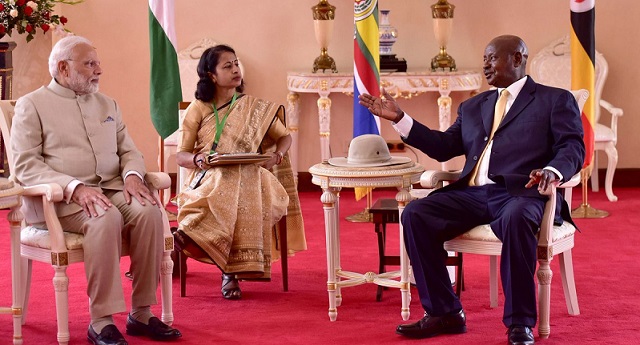
Uganda plans to intensify relations in trade, tourism and investment
Kampala, Uganda | JULIUS BUSINGE | Trade between Africa and India has recorded a 30% decline in volume from US$78billion in 2014 to about $55 billion in 2017 citing a tough economic environment.
However, this was more than seven times higher 17 years ago when the trade volumes stood at merely US$7.2bn.
These figures are contained in a report jointly produced recently by the African Export-Import Bank (Afreximbank) and Exim Bank of India (Exim India) titled; Deepening South-South Trade: An Analysis of Africa and India’s Trade and Investment.
According to the report, these latest figures make India, Africa’s fourth-largest national trading partner.
More trading by the two counterparts means increased demand for goods and services, creation of job opportunities, technology and skills transfer which all feed into the performance of the two economies.
The report notes that trade accounted for more than 6.8% of total African trade in 2017, up from 2.7% in 2001, with trade with Africa now accounting for about 8% of India’s total trade.
The report says that Africa’s exports to India remain essentially concentrated in crude oil and primary commodities while India’s exports to Africa are more diversified and include more manufactured and technological-content products.
It says that Africa’s ongoing efforts at diversifying sources of growth and structural transformation would see the composition of trade evolve to include a greater proportion of manufactured, non-traditional and agro-processed exports from Africa to India.
An assessment conducted as part of the study estimated the value of the bilateral trade potential between Africa and India to be in excess of US$42 billion per annum.
The study also showed that the attractiveness of Africa and India as investment destinations had risen in recent years, driven by strong economic growth, an improved business environment and better investment climate and regulations, high rates of return on investment, and a rising consumer market, among others.
In terms of India’s foreign direct investment (FDI) stock in Africa, the report says, this rose from US$11.9billion in 2010 to US$15.2 billion in 2014. Over the same period, Africa’s FDI stock in India increased from US$57billion to US$73.3billion, with investments in such sectors as oil and gas, agriculture, retail, healthcare and telecommunications.
In addition, India’s development cooperation with African countries has evolved to incorporate varied avenues such as trade and investment, capacity building, technology transfer, and grants and concessional loans.
Below potential
Despite the growth in trade numbers since 2001, the report indicates that the two partners were not yet operating at their full potential, attributing this to a number of constraints, including finance, infrastructure, capacity and market access, with access to finance singled out as a major inhibiting factor to trade.
The joint study was conducted by Afreximbank and Exim India as part of the ongoing collaboration to accelerate the transformation of the economies of their member countries through innovation in trade finance and expansion of South–South trade.
The timing
The report was released ahead of the visit of India’s Prime Minister, Narendra Modi to a few selected African countries – Uganda, Rwanda and South Africa.
While in Uganda, Modi and President Yoweri Museveni held bilateral talks on trade, investment and tourism among other areas. Modi also met the Indian business community in Uganda and also addressed Members of Parliament on trade and related matters.
Observers lauded Modi for his visit and were optimistic that his coming would strengthen bilateral relations between Uganda and India. The same is expected between Indian and Rwanda, and South Africa where, Modi met the presidents, the Indian Community, other groups and discussed trade and related issues.
Modi announced that India would extend credit worth US$200million to boost Uganda’s investments in key sectors of energy, infrastructure and manufacturing. Analysts welcomed this facility which would support priority sectors of development detailed in the National Development Plan II and Visions 2020 and 2040.
Critics however, say government should strengthen mechanisms of spending and monitoring projects that will be funded by this credit facility so as to achieve desired results.
For many years, Uganda has been a key trading partner with India having recorded about US$58million as total value of exports for the last five years, according to data from Bank of Uganda.
Similarly, the value of exports to Uganda from India have totalled to approx.US$1.5billion in the same period.
Additional reporting by Isaac Khisa
 The Independent Uganda: You get the Truth we Pay the Price
The Independent Uganda: You get the Truth we Pay the Price



